NumPy is a Python package that is used for scientific computing and working with multidimensional arrays. It allows fast operations on arrays through the use of n-dimensional arrays and has functions for creating, manipulating, and transforming NumPy arrays. NumPy arrays can be indexed, sliced, and various arithmetic operations can be performed on them element-wise for fast processing of large datasets.

![96 Informatics Practices – Class XI
Installing NumPy
NumPy can be installed by typing following command:
pip install NumPy
6.2 Array
We have learnt about various data types like list, tuple,
and dictionary. In this chapter we will discuss another
datatype ‘Array’. An array is a data type used to store
multiple values using a single identifier (variable name).
An array contains an ordered collection of data elements
where each element is of the same type and can be
referenced by its index (position).
The important characteristics of an array are:
• Each element of the array is of same data
type, though the values stored in them may be
different.
• The entire array is stored contiguously in
memory. This makes operations on array fast.
• Each element of the array is identified or
referred using the name of the Array along with
the index of that element, which is unique for
each element. The index of an element is an
integral value associated with the element,
based on the element’s position in the array.
For example consider an array with 5 numbers:
[ 10, 9, 99, 71, 90 ]
Here, the 1st value in the array is 10 and has the
index value [0] associated with it; the 2nd
value in the
array is 9 and has the index value [1] associated with
it, and so on. The last value (in this case the 5th
value)
in this array has an index [4]. This is called zero based
indexing. This is very similar to the indexing of lists in
Python. The idea of arrays is so important that almost
all programming languages support it in one form or
another.
6.3 NumPy Array
NumPy arrays are used to store lists of numerical data,
vectors and matrices. The NumPy library has a large set of
routines (built-in functions) for creating, manipulating,
and transforming NumPy arrays. Python language also
has an array data structure, but it is not as versatile,
efficient and useful as the NumPy array. The NumPy
Contiguous memory
allocation:
The memory space
must be divided
into the fined sized
position and each
position is allocated
to a single data only.
Now Contiguous
Memory Allocation:
Divide the data into
several blocks and
place in different
parts of the memory
according to the
availability of memory
space.
Chap 6.indd 96 19-Jul-19 3:43:32 PM
2022-23](https://image.slidesharecdn.com/numpy-220919040304-6b4cdf14/75/numpy-pdf-2-2048.jpg)
![Introduction to NumPy 97
array is officially called ndarray but commonly known
as array. In rest of the chapter, we will be referring to
NumPy array whenever we use “array”. following are few
differences between list and Array.
6.3.1 Difference Between List and Array
List Array
List can have elements of different data
types for example, [1,3.4, ‘hello’, ‘a@’]
All elements of an array are of same data type for
example, an array of floats may be: [1.2, 5.4, 2.7]
Elements of a list are not stored
contiguously in memory.
Array elements are stored in contiguous memory
locations. This makes operations on arrays faster than
lists.
Listsdonotsupportelementwiseoperations,
for example, addition, multiplication, etc.
because elements may not be of same type.
Arrays support element wise operations. For example,
if A1 is an array, it is possible to say A1/3 to divide
each element of the array by 3.
Lists can contain objects of different
datatype that Python must store the type
information for every element along with its
element value. Thus lists take more space
in memory and are less efficient.
NumPy array takes up less space in memory as
compared to a list because arrays do not require to
store datatype of each element separately.
List is a part of core Python. Array (ndarray) is a part of NumPy library.
6.3.2 Creation of NumPy Arrays from List
There are several ways to create arrays. To create an
array and to use its methods, first we need to import the
NumPy library.
#NumPy is loaded as np (we can assign any
#name), numpy must be written in lowercase
>>> import numpy as np
The NumPy’s array() function converts a given list
into an array. For example,
#Create an array called array1 from the
#given list.
>>> array1 = np.array([10,20,30])
#Display the contents of the array
>>> array1
array([10, 20, 30])
• Creating a 1-D Array
An array with only single row of elements is called
1-D array. Let us try to create a 1-D array from
a list which contains numbers as well as strings.
>>> array2 = np.array([5,-7.4,'a',7.2])
>>> array2
Chap 6.indd 97 19-Jul-19 3:43:32 PM
2022-23](https://image.slidesharecdn.com/numpy-220919040304-6b4cdf14/75/numpy-pdf-3-2048.jpg)
![98 Informatics Practices – Class XI
array(['5', '-7.4', 'a', '7.2'],
dtype='<U32')
Observe that since there is a string value in the
list, all integer and float values have been promoted to
string, while converting the list to array.
Note: U32 means Unicode-32 data type.
• Creating a 2-D Array
We can create a two dimensional (2-D) arrays by
passing nested lists to the array() function.
Example 6.1
>>> array3 = np.array([[2.4,3],
[4.91,7],[0,-1]])
>>> array3
array([[ 2.4 , 3. ],
[ 4.91, 7. ],
[ 0. , -1. ]])
Observe that the integers 3, 7, 0 and -1 have been
promoted to floats.
6.3.3 Attributes of NumPy Array
Some important attributes of a NumPy ndarray object are:
i) ndarray.ndim: gives the number of dimensions
of the array as an integer value. Arrays can be
1-D, 2-D or n-D. In this chapter, we shall focus
on 1-D and 2-D arrays only. NumPy calls the
dimensions as axes (plural of axis). Thus, a 2-D
array has two axes. The row-axis is called axis-0
and the column-axis is called axis-1. The number
of axes is also called the array’s rank.
Example 6.2
>>> array1.ndim
1
>>> array3.ndim
2
ii) ndarray.shape: It gives the sequence of integers
indicating the size of the array for each dimension.
Example 6.3
# array1 is 1D-array, there is nothing
# after , in sequence
>>> array1.shape
(3,)
>>> array2.shape
(4,)
>>> array3.shape
(3, 2)
A common mistake
occurs while passing
argument to array() if
we forget to put square
brackets. Make sure
only a single argument
containing list of
values is passed.
#incorrect way
>>> a =
np.array(1,2,3,4)
#correct way
>>> a =
np.array([1,2,3,4])
A list is called nested
list when each
element is a list itself.
Chap 6.indd 98 19-Jul-19 3:43:32 PM
2022-23](https://image.slidesharecdn.com/numpy-220919040304-6b4cdf14/75/numpy-pdf-4-2048.jpg)
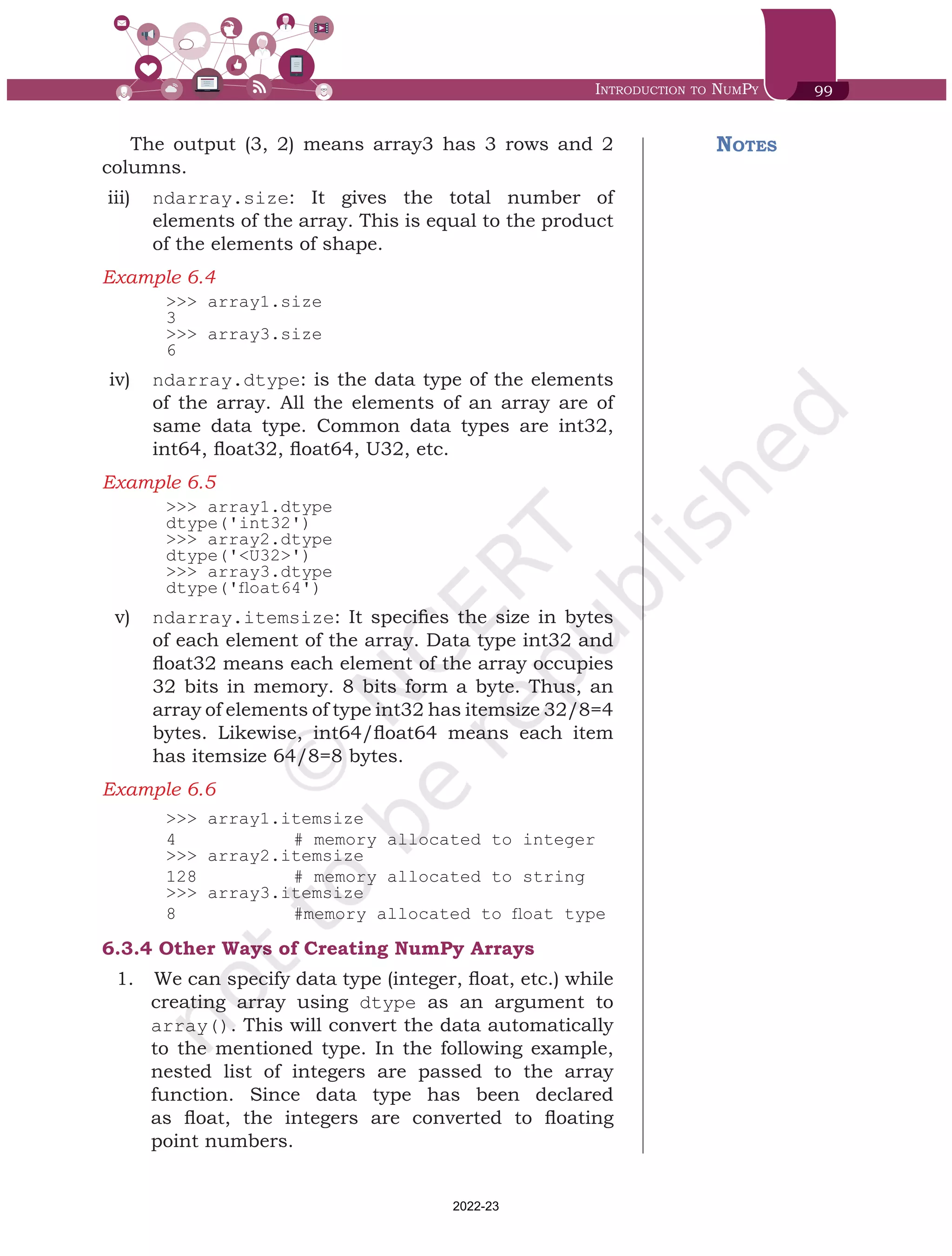
![100 Informatics Practices – Class XI
>>> array4 = np.array( [ [1,2], [3,4] ],
dtype=float)
>>> array4
array([[1., 2.],
[3., 4.]])
2. We can create an array with all elements initialised
to 0 using the function zeros(). By default, the
data type of the array created by zeros() is float.
The following code will create an array with 3 rows
and 4 columns with each element set to 0.
>>> array5 = np.zeros((3,4))
>>> array5
array([[0., 0., 0., 0.],
[0., 0., 0., 0.],
[0., 0., 0., 0.]])
3. We can create an array with all elements initialised
to 1 using the function ones(). By default, the
data type of the array created by ones() is float.
The following code will create an array with 3 rows
and 2 columns.
>>> array6 = np.ones((3,2))
>>> array6
array([[1., 1.],
[1., 1.],
[1., 1.]])
4. We can create an array with numbers in a given
range and sequence using the arange() function.
This function is analogous to the range() function
of Python.
>>> array7 = np.arange(6)
# an array of 6 elements is created with
start value 5 and step size 1
>>> array7
array([0, 1, 2, 3, 4, 5])
# Creating an array with start value -2, end
# value 24 and step size 4
>>> array8 = np.arange( -2, 24, 4 )
>>> array8
array([-2, 2, 6, 10, 14, 18, 22])
6.4 Indexing and Slicing
NumPy arrays can be indexed, sliced and iterated over.
6.4.1 Indexing
We have learnt about indexing single-dimensional
array in section 6.2. For 2-D arrays indexing for both
dimensions starts from 0, and each element is referenced
through two indexes i and j, where i represents the row
number and j represents the column number.
Think and Reflect
When we may require
to create an array
initialised to zeros or
ones?
Chap 6.indd 100 19-Jul-19 3:43:32 PM
2022-23](https://image.slidesharecdn.com/numpy-220919040304-6b4cdf14/75/numpy-pdf-6-2048.jpg)
![Introduction to NumPy 101
Table 6.1 Marks of students in different subjects
Name Maths English Science
Ramesh 78 67 56
Vedika 76 75 47
Harun 84 59 60
Prasad 67 72 54
Consider Table 6.1 showing marks obtained by
students in three different subjects. Let us create an
array called marks to store marks given in three subjects
for four students given in this table. As there are 4
students (i.e. 4 rows) and 3 subjects (i.e. 3 columns),
the array will be called marks[4][3]. This array can
store 4*3 = 12 elements.
Here, marks[i,j] refers to the element at (i+1)th
row
and (j+1)th
column because the index values start at 0.
Thus marks[3,1] is the element in 4th
row and second
column which is 72 (marks of Prasad in English).
# accesses the element in the 1st
row in
# the 3rd
column
>>> marks[0,2]
56
>>> marks [0,4]
index Out of Bound "Index Error". Index 4
is out of bounds for axis with size 3
6.4.2 Slicing
Sometimes we need to extract part of an array. This is
done through slicing. We can define which part of the
array to be sliced by specifying the start and end index
values using [start : end] along with the array name.
Example 6.7
>>> array8
array([-2, 2, 6, 10, 14, 18, 22])
# excludes the value at the end index
>>> array8[3:5]
array([10, 14])
# reverse the array
>>> array8[ : : -1]
array([22, 18, 14, 10, 6, 2, -2])
Notes
Chap 6.indd 101 19-Jul-19 3:43:32 PM
2022-23](https://image.slidesharecdn.com/numpy-220919040304-6b4cdf14/75/numpy-pdf-7-2048.jpg)
![102 Informatics Practices – Class XI
Now let us see how slicing is done for 2-D arrays.
For this, let us create a 2-D array called array9 having
3 rows and 4 columns.
>>> array9 = np.array([[ -7, 0, 10, 20],
[ -5, 1, 40, 200],
[ -1, 1, 4, 30]])
# access all the elements in the 3rd
column
>>> array9[0:3,2]
array([10, 40, 4])
Note that we are specifying rows in the range 0:3
because the end value of the range is excluded.
# access elements of 2nd
and 3rd
row from 1st
# and 2nd
column
>>> array9[1:3,0:2]
array([[-5, 1],
[-1, 1]])
If row indices are not specified, it means all the rows
are to be considered. Likewise, if column indices are
not specified, all the columns are to be considered.
Thus, the statement to access all the elements in the 3rd
column can also be written as:
>>>array9[:,2]
array([10, 40, 4])
6.5 Operations on Arrays
Once arrays are declared, we con access it's element
or perform certain operations the last section, we
learnt about accessing elements. This section describes
multiple operations that can be applied on arrays.
6.5.1 Arithmetic Operations
Arithmetic operations on NumPy arrays are fast and
simple. When we perform a basic arithmetic operation
like addition, subtraction, multiplication, division etc. on
two arrays, the operation is done on each corresponding
pair of elements. For instance, adding two arrays will
result in the first element in the first array to be added
to the first element in the second array, and so on.
Consider the following element-wise operations on two
arrays:
>>> array1 = np.array([[3,6],[4,2]])
>>> array2 = np.array([[10,20],[15,12]])
Notes
Chap 6.indd 102 19-Jul-19 3:43:32 PM
2022-23](https://image.slidesharecdn.com/numpy-220919040304-6b4cdf14/75/numpy-pdf-8-2048.jpg)
![Introduction to NumPy 103
#Element-wise addition of two matrices.
>>> array1 + array2
array([[13, 26],
[19, 14]])
#Subtraction
>>> array1 - array2
array([[ -7, -14],
[-11, -10]])
#Multiplication
>>> array1 * array2
array([[ 30, 120],
[ 60, 24]])
#Matrix Multiplication
>>> array1 @ array2
array([[120, 132],
[ 70, 104]])
#Exponentiation
>>> array1 ** 3
array([[ 27, 216],
[ 64, 8]], dtype=int32)
#Division
>>> array2 / array1
array([[3.33333333, 3.33333333],
[3.75 , 6. ]])
#Element wise Remainder of Division
#(Modulo)
>>> array2 % array1
array([[1, 2],
[3, 0]], dtype=int32)
It is important to note that for element-wise
operations, size of both arrays must be same. That is,
array1.shape must be equal to array2.shape.
6.5.2 Transpose
Transposing an array turns its rows into columns and
columns into rows just like matrices in mathematics.
#Transpose
>>> array3 = np.array([[10,-7,0, 20],
[-5,1,200,40],[30,1,-1,4]])
>>> array3
array([[ 10, -7, 0, 20],
[ -5, 1, 200, 40],
[ 30, 1, -1, 4]])
Notes
Chap 6.indd 103 19-Jul-19 3:43:32 PM
2022-23](https://image.slidesharecdn.com/numpy-220919040304-6b4cdf14/75/numpy-pdf-9-2048.jpg)
![104 Informatics Practices – Class XI
# the original array does not change
>>> array3.transpose()
array([[ 10, -5, 30],
[ -7, 1, 1],
[ 0, 200, -1],
[ 20, 40, 4]])
6.5.3 Sorting
Sorting is to arrange the elements of an array in
hierarchical order either ascending or descending. By
default, numpy does sorting in ascending order.
>>> array4 = np.array([1,0,2,-3,6,8,4,7])
>>> array4.sort()
>>> array4
array([-3, 0, 1, 2, 4, 6, 7, 8])
In 2-D array, sorting can be done along either of the
axes i.e., row-wise or column-wise. By default, sorting
is done row-wise (i.e., on axis = 1). It means to arrange
elements in each row in ascending order. When axis=0,
sorting is done column-wise, which means each column
is sorted in ascending order.
>>> array4 = np.array([[10,-7,0, 20],
[-5,1,200,40],[30,1,-1,4]])
>>> array4
array([[ 10, -7, 0, 20],
[ -5, 1, 200, 40],
[ 30, 1, -1, 4]])
#default is row-wise sorting
>>> array4.sort()
>>> array4
array([[ -7, 0, 10, 20],
[ -5, 1, 40, 200],
[ -1, 1, 4, 30]])
>>> array5 = np.array([[10,-7,0, 20],
[-5,1,200,40],[30,1,-1,4]])
#axis =0 means column-wise sorting
>>> array5.sort(axis=0)
>>> array5
array([[ -5, -7, -1, 4],
[ 10, 1, 0, 20],
[ 30, 1, 200, 40]])
6.6 Concatenating Arrays
Concatenation means joining two or more arrays.
Concatenating 1-D arrays means appending the
sequences one after another. NumPy.concatenate()
Notes
Chap 6.indd 104 19-Jul-19 3:43:32 PM
2022-23](https://image.slidesharecdn.com/numpy-220919040304-6b4cdf14/75/numpy-pdf-10-2048.jpg)
![Introduction to NumPy 105
function can be used to concatenate two or more
2-D arrays either row-wise or column-wise. All the
dimensions of the arrays to be concatenated must match
exactly except for the dimension or axis along which
they need to be joined. Any mismatch in the dimensions
results in an error. By default, the concatenation of the
arrays happens along axis=0.
Example 6.8
>>> array1 = np.array([[10, 20], [-30,40]])
>>> array2 = np.zeros((2, 3), dtype=array1.
dtype)
>>> array1
array([[ 10, 20],
[-30, 40]])
>>> array2
array([[0, 0, 0],
[0, 0, 0]])
>>> array1.shape
(2, 2)
>>> array2.shape
(2, 3)
>>> np.concatenate((array1,array2), axis=1)
array([[ 10, 20, 0, 0, 0],
[-30, 40, 0, 0, 0]])
>>> np.concatenate((array1,array2), axis=0)
Traceback (most recent call last):
File "<pyshell#3>", line 1, in <module>
np.concatenate((array1,array2))
ValueError: all the input array dimensions
except for the concatenation axis must
match exactly
6.7 Reshaping Arrays
We can modify the shape of an array using the reshape()
function. Reshaping an array cannot be used to change
the total number of elements in the array. Attempting
to change the number of elements in the array using
reshape() results in an error.
Example 6.9
>>> array3 = np.arange(10,22)
>>> array3
array([10, 11, 12, 13, 14, 15, 16, 17, 18,
19, 20, 21])
Notes
Chap 6.indd 105 19-Jul-19 3:43:32 PM
2022-23](https://image.slidesharecdn.com/numpy-220919040304-6b4cdf14/75/numpy-pdf-11-2048.jpg)
![106 Informatics Practices – Class XI
>>> array3.reshape(3,4)
array([[10, 11, 12, 13],
[14, 15, 16, 17],
[18, 19, 20, 21]])
>>> array3.reshape(2,6)
array([[10, 11, 12, 13, 14, 15],
[16, 17, 18, 19, 20, 21]])
6.8 Splitting Arrays
We can split an array into two or more subarrays.
numpy.split() splits an array along the specified axis.
We can either specify sequence of index values where an
array is to be split; or we can specify an integer N, that
indicates the number of equal parts in which the array
is to be split, as parameter(s) to the NumPy.split()
function. By default, NumPy.split() splits along axis =
0. Consider the array given below:
>>> array4
array([[ 10, -7, 0, 20],
[ -5, 1, 200, 40],
[ 30, 1, -1, 4],
[ 1, 2, 0, 4],
[ 0, 1, 0, 2]])
# [1,3] indicate the row indices on which
# to split the array
>>> first, second, third = numpy split(array4,
[1, 3])
# array4 is split on the first row and
# stored on the sub-array first
>>> first
array([[10, -7, 0, 20]])
# array4 is split after the first row and
# upto the third row and stored on the
# sub-array second
>>> second
array([[ -5, 1, 200, 40],
[ 30, 1, -1, 4]])
# the remaining rows of array4 are stored
# on the sub-array third
>>> third
array([[1, 2, 0, 4],
[0, 1, 0, 2]])
Notes
Chap 6.indd 106 19-Jul-19 3:43:32 PM
2022-23](https://image.slidesharecdn.com/numpy-220919040304-6b4cdf14/75/numpy-pdf-12-2048.jpg)
![Introduction to NumPy 107
#[1, 2], axis=1 give the columns indices
#along which to split
>>> firstc, secondc, thirdc =numpy split(array4,
[1, 2], axis=1)
>>> firstc
array([[10],
[-5],
[30],
[ 1],
[ 0]])
>>> secondc
array([[-7],
[ 1],
[ 1],
[ 2],
[ 1]])
>>> thirdc
array([[ 0, 20],
[200, 40],
[ -1, 4],
[ 0, 4],
[ 0, 2]])
# 2nd
parameter 2 implies array is to be
# split in 2 equal parts axis=1 along the
# column axis
>>> firsthalf, secondhalf =np.split(array4,2,
axis=1)
>>> firsthalf
array([[10, -7],
[-5, 1],
[30, 1],
[ 1, 2],
[ 0, 1]])
>>> secondhalf
array([[ 0, 20],
[200, 40],
[ -1, 4],
[ 0, 4],
[ 0, 2]])
6.9 Statistical Operations on Arrays
NumPy provides functions to perform many useful
statistical operations on arrays. In this section, we will
apply the basic statistical techniques called descriptive
statistics that we have learnt in chapter 5.
Notes
Chap 6.indd 107 19-Jul-19 3:43:32 PM
2022-23](https://image.slidesharecdn.com/numpy-220919040304-6b4cdf14/75/numpy-pdf-13-2048.jpg)
![108 Informatics Practices – Class XI
Let us consider two arrays:
>>> arrayA = np.array([1,0,2,-3,6,8,4,7])
>>> arrayB = np.array([[3,6],[4,2]])
1. The max() function finds the maximum element
from an array.
# max element form the whole 1-D array
>>> arrayA.max()
8
# max element form the whole 2-D array
>>> arrayB.max()
6
# if axis=1, it gives column wise maximum
>>> arrayB.max(axis=1)
array([6, 4])
# if axis=0, it gives row wise maximum
>>> arrayB.max(axis=0)
array([4, 6])
2. The min() function finds the minimum element
from an array.
>>> arrayA.min()
-3
>>> arrayB.min()
2
>>> arrayB.min(axis=0)
array([3, 2])
3. The sum() function finds the sum of all elements
of an array.
>>> arrayA.sum()
25
>>> arrayB.sum()
15
#axis is used to specify the dimension
#on which sum is to be made. Here axis = 1
#means the sum of elements on the first row
>>> arrayB.sum(axis=1)
array([9, 6])
4. The mean() function finds the average of elements
of the array.
>>> arrayA.mean()
3.125
>>> arrayB.mean()
3.75
>>> arrayB.mean(axis=0)
array([3.5, 4. ])
>>> arrayB.mean(axis=1)
array([4.5, 3. ])
5. The std() function is used to find standard
deviation of an array of elements.
>>> arrayA.std()
3.550968177835448
Notes
Chap 6.indd 108 19-Jul-19 3:43:32 PM
2022-23](https://image.slidesharecdn.com/numpy-220919040304-6b4cdf14/75/numpy-pdf-14-2048.jpg)
![Introduction to NumPy 109
>>> arrayB.std()
1.479019945774904
>>> arrayB.std(axis=0)
array([0.5, 2. ])
>>> arrayB.std(axis=1)
array([1.5, 1. ])
6.10 Loading Arrays from Files
Sometimes, we may have data in files and we may need
to load that data in an array for processing. numpy.
loadtxt() and numpy.genfromtxt()are the two
functions that can be used to load data from text files.
The most commonly used file type to handle large amount
of data is called CSV (Comma Separated Values).
Each row in the text file must have the same number
of values in order to load data from a text file into a
numpy array. Let us say we have the following data in a
text file named data.txt stored in the folder C:/NCERT.
RollNo Marks1 Marks2 Marks3
1, 36, 18, 57
2, 22, 23, 45
3, 43, 51, 37
4, 41, 40, 60
5, 13, 18, 37
We can load the data from the data.txt file into an
array say, studentdata in the following manner:
6.10.1 Using NumPy.loadtxt()
>>> studentdata = np.loadtxt('C:/NCERT/
data.txt', skiprows=1, delimiter=',',
dtype = int)
>>> studentdata
array([[ 1, 36, 18, 57],
[ 2, 22, 23, 45],
[ 3, 43, 51, 37],
[ 4, 41, 40, 60],
[ 5, 13, 18, 27]])
In the above statement, first we specify the name
and path of the text file containing the data. Let us
understand some of the parameters that we pass in the
np.loadtext() function:
Notes
Chap 6.indd 109 19-Jul-19 3:43:32 PM
2022-23](https://image.slidesharecdn.com/numpy-220919040304-6b4cdf14/75/numpy-pdf-15-2048.jpg)
![110 Informatics Practices – Class XI
• The parameter skiprows=1 indicates that the
first row is the header row and therefore we
need to skip it as we do not want to load it in
the array.
• The delimiter specifies whether the values are
separated by comma, semicolon, tab or space
(the four are together called whitespace), or any
other character. The default value for delimiter
is space.
• We can also specify the data type of the array
to be created by specifying through the dtype
argument. By default, dtype is float.
We can load each row or column of the data file into
different numpy arrays using the unpack parameter.
By default, unpack=False means we can extract each
row of data as separate arrays. When unpack=True, the
returned array is transposed means we can extract the
columns as separate arrays.
# To import data into multiple NumPy arrays
# row wise. Values related to student1 in
# array stud1, student2 in array stud2 etc.
>>> stud1, stud2, stud3, stud4, stud5 =
np.loadtxt('C:/NCERT/data.txt',skiprows=1,
delimiter=',', dtype = int)
>>> stud1
array([ 1, 36, 18, 57])
>>> stud2
array([ 2, 22, 23, 45]) # and so on
# Import data into multiple arrays column
# wise. Data in column RollNo will be put
# in array rollno, data in column Marks1
# will be put in array mks1 and so on.
>>> rollno, mks1, mks2, mks3 =
np.loadtxt('C:/NCERT/data.txt',
skiprows=1, delimiter=',', unpack=True,
dtype = int)
>>> rollno
array([1, 2, 3, 4, 5])
>>> mks1
array([36, 22, 43, 41, 13])
>>> mks2
array([18, 23, 51, 40, 18])
>>> mks3
array([57, 45, 37, 60, 27])
.CSV files or comma
separated values
files are a type of text
files that have values
separated by commas.
A CSV file stores
tabular data in a text
file. CSV files can
be loaded in NumPy
arrays and their data
can be analyzed using
these functions.
Chap 6.indd 110 19-Jul-19 3:43:32 PM
2022-23](https://image.slidesharecdn.com/numpy-220919040304-6b4cdf14/75/numpy-pdf-16-2048.jpg)
![Introduction to NumPy 111
6.10.2 Using NumPy.genfromtxt()
genfromtxt() is another function in NumPy to load data
from files. As compared to loadtxt(), genfromtxt()
can also handle missing values in the data file. Let us
look at the following file dataMissing.txt with some
missing values and some non-numeric data:
RollNo Marks1 Marks2 Marks3
1, 36, 18, 57
2, ab, 23, 45
3, 43, 51,
4, 41, 40, 60
5, 13, 18, 27
>>> dataarray = np.genfromtxt('C:/NCERT/
dataMissing.txt',skip_header=1,
delimiter = ',')
>>> dataarray
array([[ 1., 36., 18., 57.],
[ 2., nan, 23., 45.],
[ 3., 43., 51., nan],
[ 4., 41., 40., 60.],
[ 5., 13., 18., 27.]])
The genfromtxt() function converts missing values
and character strings in numeric columns to nan. But if
we specify dtype as int, it converts the missing or other
non numeric values to -1. We can also convert these
missing values and character strings in the data files
to some specific value using the parameter filling_
values.
Example 6.10 Let us set the value of the missing or non
numeric data to -999:
>>> dataarray = np.genfromtxt('C:/NCERT/
dataMissing.txt',skip_header=1,
delimiter=',', filling_values=-999,
dtype = int)
>>> dataarray
array([[ 1, 36, 18, 57],
[ 2, -999, 23, 45],
[ 3, 43, 51, -999],
[ 4, 41, 40, 60],
[ 5, 13, 18, 27]])
Activity 6.1
Can you write the
command to load the
data.txt including the
header row as well?
Activity 6.2
Can you create a
datafile and import
data into multiple
NumPy arrays column
wise? (Hint: use unpack
parameter)
Chap 6.indd 111 19-Jul-19 3:43:32 PM
2022-23](https://image.slidesharecdn.com/numpy-220919040304-6b4cdf14/75/numpy-pdf-17-2048.jpg)
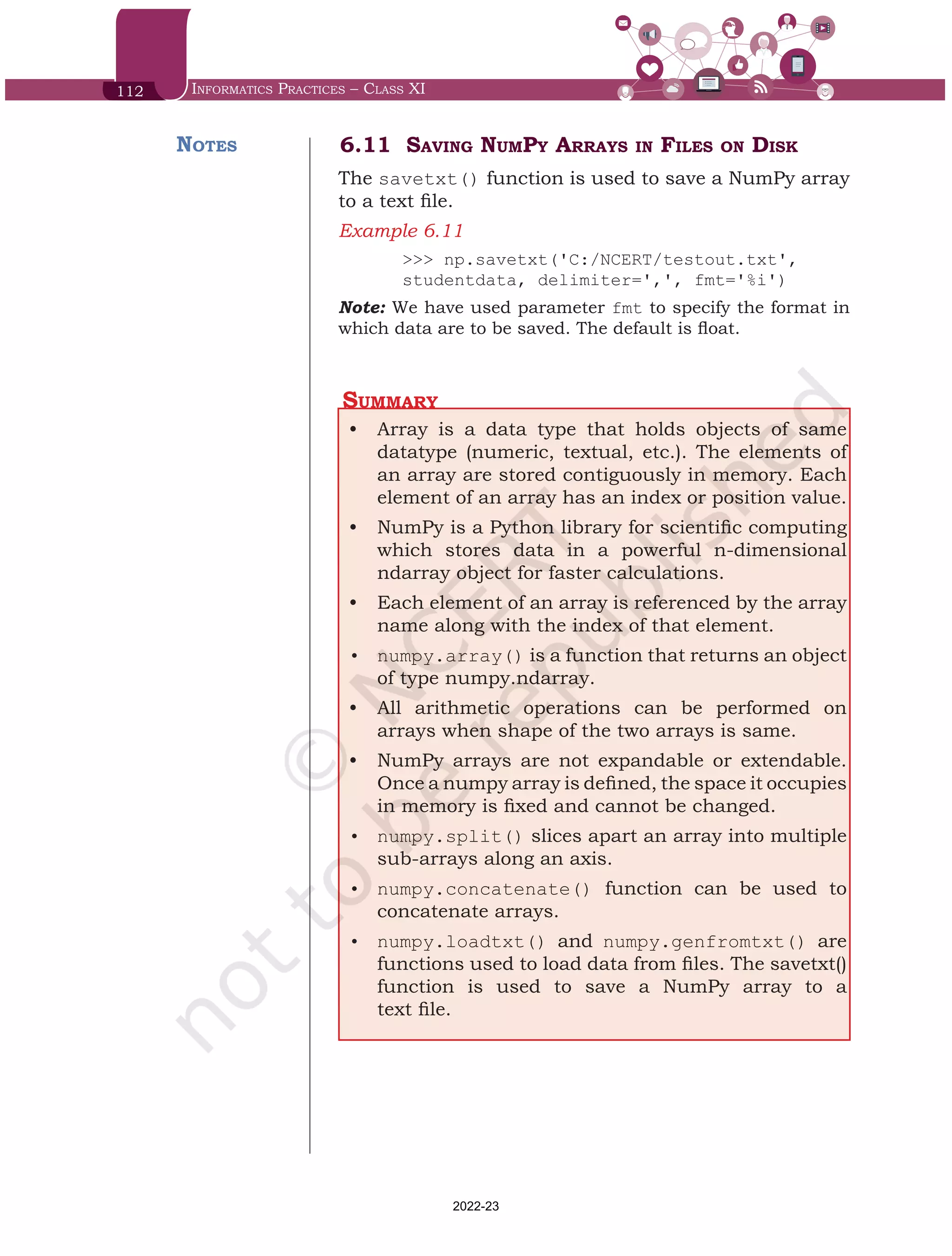
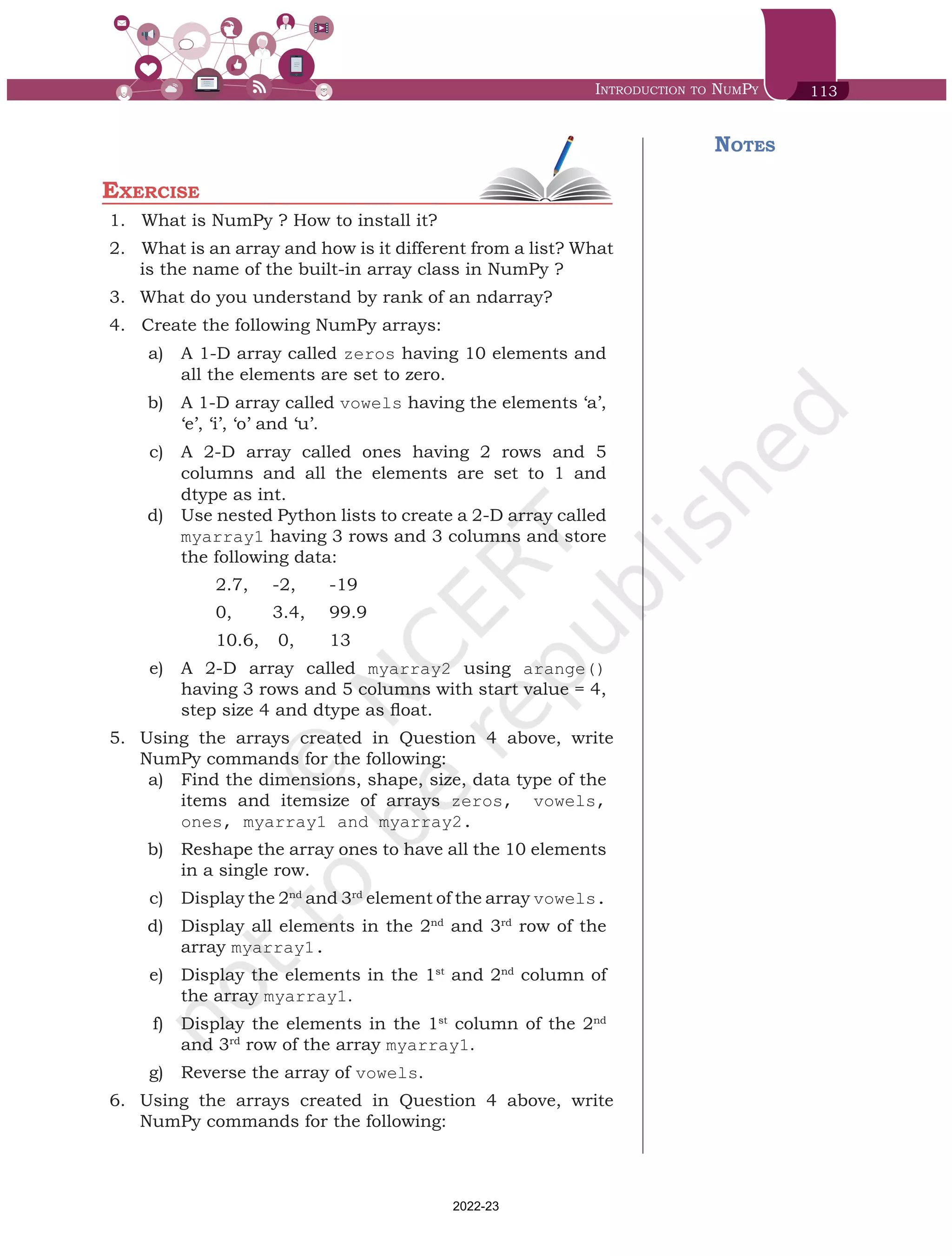

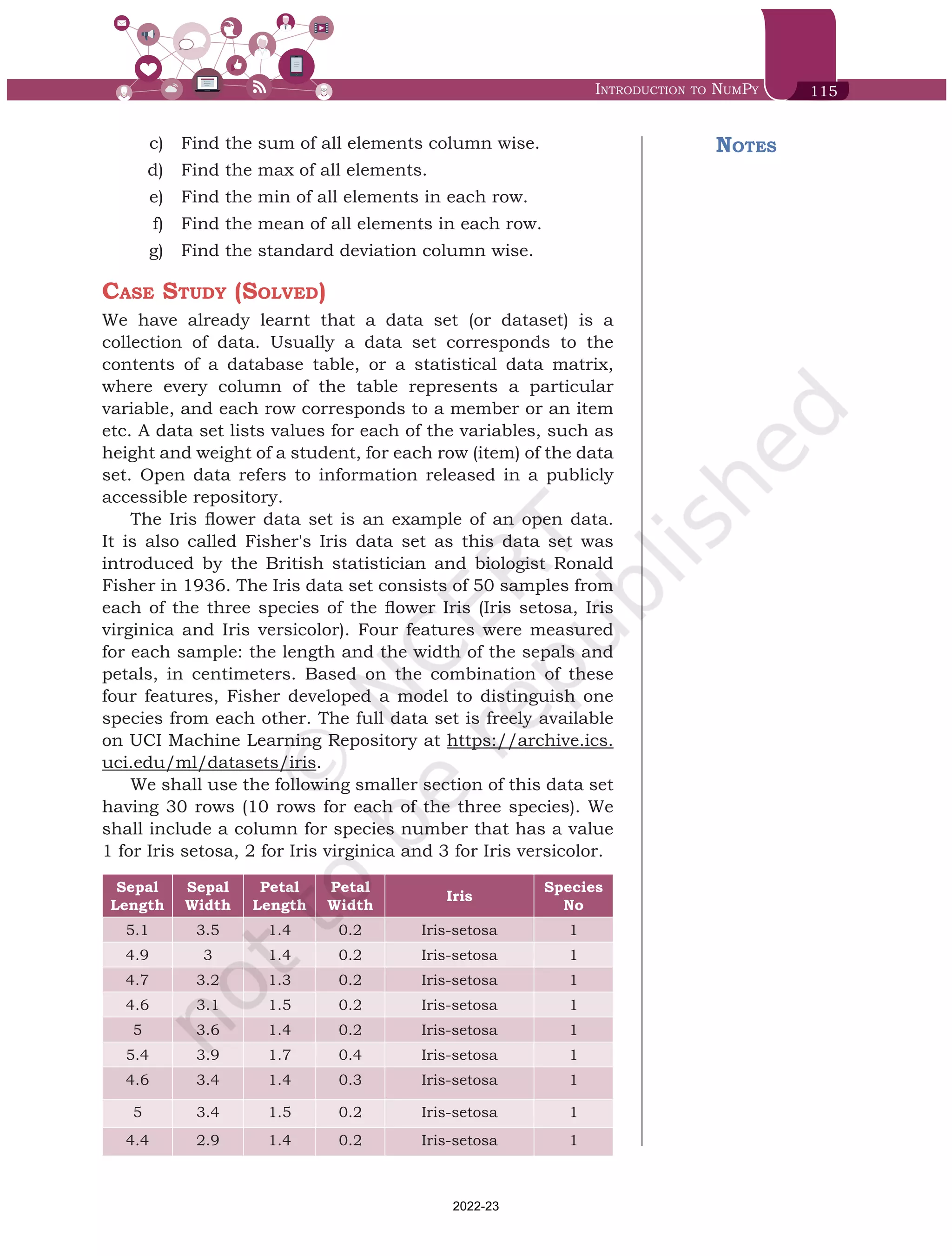

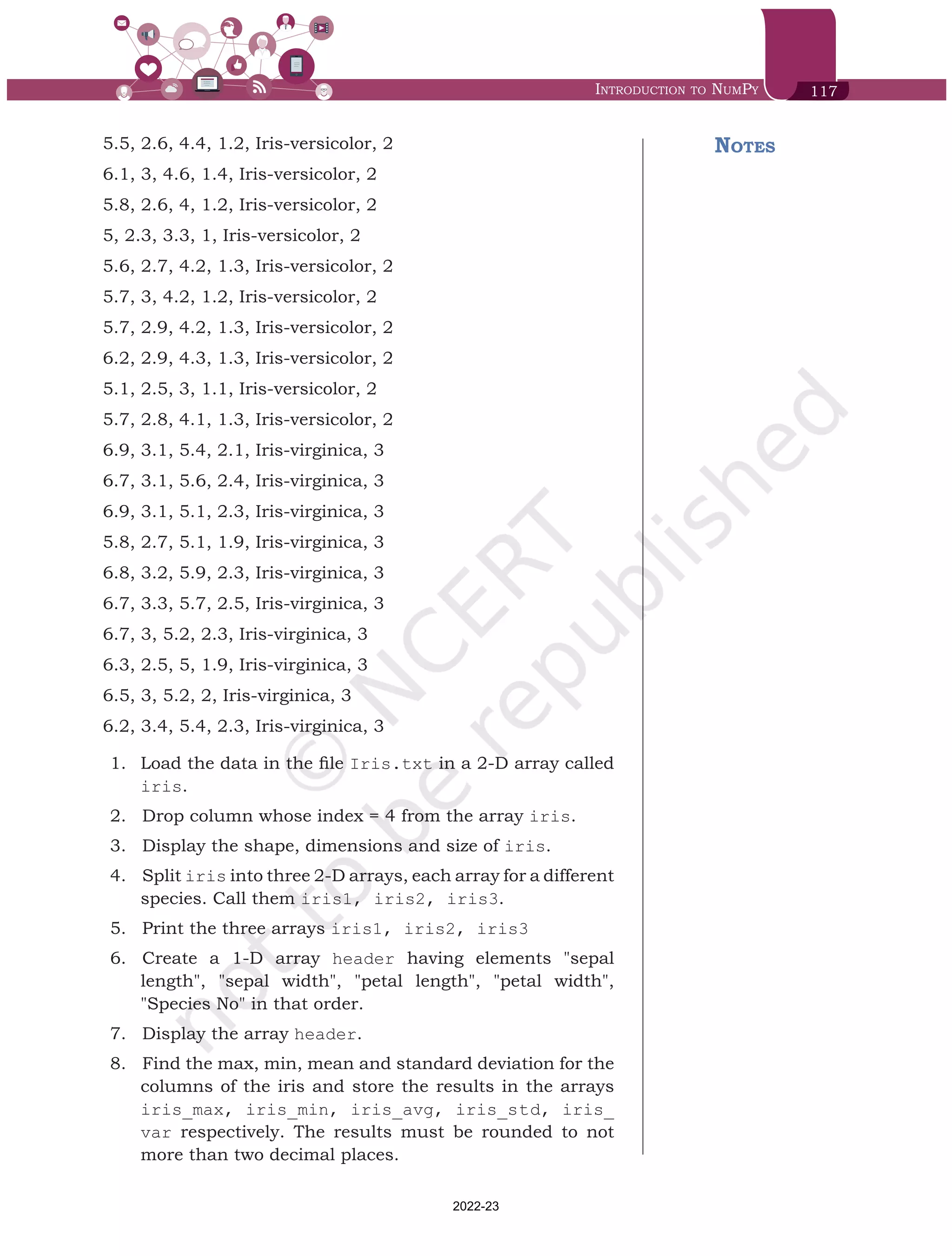
![118 Informatics Practices – Class XI
9.
Similarly find the max, min, mean and standard deviation
for the columns of the iris1, iris2 and iris3 and
store the results in the arrays with appropriate names.
10.
Check the minimum value for sepal length, sepal width,
petal length and petal width of the three species in
comparison to the minimum value of sepal length, sepal
width, petal length and petal width for the data set as a
whole and fill the table below with True if the species value
is greater than the dataset value and False otherwise.
Iris setosa Iris virginica Iris versicolor
sepal length
sepal width
petal length
petal width
11.
Compare Iris setosa’s average sepal width to that of Iris
virginica.
12.
Compare Iris setosa’s average petal length to that of Iris
virginica.
13.
Compare Iris setosa’s average petal width to that of Iris
virginica.
14.
Save the array iris_avg in a comma separated file
named IrisMeanValues.txt on the hard disk.
15.
Save the arrays iris_max, iris_avg, iris_min in
a comma separated file named IrisStat.txt on the
hard disk.
Solutions to Case Study based Exercises
>>> import numpy as np
# Solution to Q1
>>> iris = np.genfromtxt('C:/NCERT/Iris.txt',skip_
header=1, delimiter=',', dtype = float)
# Solution to Q2
>>> iris = iris[0:30,[0,1,2,3,5]] # drop column 4
# Solution to Q3
>>> iris.shape
(30, 5)
>>> iris.ndim
Notes
Chap 6.indd 118 19-Jul-19 3:43:33 PM
2022-23](https://image.slidesharecdn.com/numpy-220919040304-6b4cdf14/75/numpy-pdf-24-2048.jpg)
![Introduction to NumPy 119
2
>>> iris.size
150
# Solution to Q4
# Split into three arrays, each array for a different
# species
>>> iris1, iris2, iris3 = np.split(iris, [10,20],
axis=0)
# Solution to Q5
# Print the three arrays
>>> iris1
array([[5.1, 3.5, 1.4, 0.2, 1. ],
[4.9, 3. , 1.4, 0.2, 1. ],
[4.7, 3.2, 1.3, 0.2, 1. ],
[4.6, 3.1, 1.5, 0.2, 1. ],
[5. , 3.6, 1.4, 0.2, 1. ],
[5.4, 3.9, 1.7, 0.4, 1. ],
[4.6, 3.4, 1.4, 0.3, 1. ],
[5. , 3.4, 1.5, 0.2, 1. ],
[4.4, 2.9, 1.4, 0.2, 1. ],
[4.9, 3.1, 1.5, 0.1, 1. ]])
>>> iris2
array([[5.5, 2.6, 4.4, 1.2, 2. ],
[6.1, 3. , 4.6, 1.4, 2. ],
[5.8, 2.6, 4. , 1.2, 2. ],
[5. , 2.3, 3.3, 1. , 2. ],
[5.6, 2.7, 4.2, 1.3, 2. ],
[5.7, 3. , 4.2, 1.2, 2. ],
[5.7, 2.9, 4.2, 1.3, 2. ],
[6.2, 2.9, 4.3, 1.3, 2. ],
[5.1, 2.5, 3. , 1.1, 2. ],
[5.7, 2.8, 4.1, 1.3, 2. ]])
>>> iris3
array([[6.9, 3.1, 5.4, 2.1, 3. ],
[6.7, 3.1, 5.6, 2.4, 3. ],
[6.9, 3.1, 5.1, 2.3, 3. ],
[5.8, 2.7, 5.1, 1.9, 3. ],
[6.8, 3.2, 5.9, 2.3, 3. ],
[6.7, 3.3, 5.7, 2.5, 3. ],
[6.7, 3. , 5.2, 2.3, 3. ],
[6.3, 2.5, 5. , 1.9, 3. ],
[6.5, 3. , 5.2, 2. , 3. ],
[6.2, 3.4, 5.4, 2.3, 3. ]])
Notes
Chap 6.indd 119 19-Jul-19 3:43:33 PM
2022-23](https://image.slidesharecdn.com/numpy-220919040304-6b4cdf14/75/numpy-pdf-25-2048.jpg)
![120 Informatics Practices – Class XI
# Solution to Q6
>>> header =np.array(["sepal length", "sepal
width", "petal length", "petal width",
"Species No"])
# Solution to Q7
>>> print(header)
['sepal length' 'sepal width' 'petal length' 'petal
width' 'Species No']
# Solution to Q8
# Stats for array iris
# Finds the max of the data for sepal length, sepal
width, petal length, petal width, Species No
>>> iris_max = iris.max(axis=0)
>>> iris_max
array([6.9, 3.9, 5.9, 2.5, 3. ])
# Finds the min of the data for sepal length, sepal
# width, petal length, petal width, Species No
>>> iris_min = iris.min(axis=0)
>>> iris_min
array([4.4, 2.3, 1.3, 0.1, 1. ])
# Finds the mean of the data for sepal length, sepal
# width, petal length, petal width, Species No
>>> iris_avg = iris.mean(axis=0).round(2)
>>> iris_avg
array([5.68, 3.03, 3.61, 1.22, 2. ])
# Finds the standard deviation of the data for sepal
# length, sepal width, petal length, petal width,
# Species No
>>> iris_std = iris.std(axis=0).round(2)
>>> iris_std
array([0.76, 0.35, 1.65, 0.82, 0.82])
# Solution to Q9
>>> iris1_max = iris1.max(axis=0)
>>> iris1_max
array([5.4, 3.9, 1.7, 0.4, 1. ])
>>> iris2_max = iris2.max(axis=0)
>>> iris2_max
array([6.2, 3. , 4.6, 1.4, 2. ])
Notes
Chap 6.indd 120 19-Jul-19 3:43:33 PM
2022-23](https://image.slidesharecdn.com/numpy-220919040304-6b4cdf14/75/numpy-pdf-26-2048.jpg)
![Introduction to NumPy 121
>>> iris3_max = iris3.max(axis=0)
>>> iris3_max
array([6.9, 3.4, 5.9, 2.5, 3. ])
>>> iris1_min = iris1.min(axis=0)
>>> iris1_min
array([4.4, 2.9, 1.3, 0.1, 1. ])
>>> iris2_min = iris2.min(axis=0)
>>> iris2_min
array([5. , 2.3, 3. , 1. , 2. ])
>>> iris3_min = iris3.min(axis=0)
>>> iris3_min
array([5.8, 2.5, 5. , 1.9, 3. ])
>>> iris1_avg = iris1.mean(axis=0)
>>> iris1_avg
array([4.86, 3.31, 1.45, 0.22, 1. ])
>>> iris2_avg = iris2.mean(axis=0)
>>> iris2_avg
array([5.64, 2.73, 4.03, 1.23, 2. ])
>>> iris3_avg = iris3.mean(axis=0)
>>> iris3_avg
array([6.55, 3.04, 5.36, 2.2 , 3. ])
>>> iris1_std = iris1.std(axis=0).round(2)
>>> iris1_std
array([0.28, 0.29, 0.1 , 0.07, 0. ])
>>> iris2_std = iris2.std(axis=0).round(2)
>>> iris2_std
array([0.36, 0.22, 0.47, 0.11, 0. ])
>>> iris3_std = iris3.std(axis=0).round(2)
>>> iris3_std
array([0.34, 0.25, 0.28, 0.2 , 0. ])
# Solution to Q10 (solve other parts on the same lines)
# min sepal length of each species Vs the min sepal
# length in the data set
>>> iris1_min[0] > iris_min[0] #sepal length
False
Notes
Chap 6.indd 121 19-Jul-19 3:43:33 PM
2022-23](https://image.slidesharecdn.com/numpy-220919040304-6b4cdf14/75/numpy-pdf-27-2048.jpg)
![122 Informatics Practices – Class XI
>>> iris2_min[0] > iris_min[0]
True
>>> iris3_min[0] > iris_min[0]
True
# Solution to Q11
#Compare Iris setosa and Iris virginica
>>> iris1_avg[1] > iris2_avg[1] #sepal width
True
# Solution to Q12
>>> iris1_avg[2] > iris2_avg[2] #petal length
False
# Solution to Q13
>>> iris1_avg[3] > iris2_avg[3] #petal width
False
# Solution to Q14
>>> np.savetxt('C:/NCERT/IrisMeanValues.txt',
iris_avg, delimiter = ',')
# Solution to Q15
>>> np.savetxt('C:/NCERT/IrisStat.txt', (iris_
max, iris_avg, iris_min), delimiter=',')
Notes
Chap 6.indd 122 19-Jul-19 3:43:33 PM
2022-23](https://image.slidesharecdn.com/numpy-220919040304-6b4cdf14/75/numpy-pdf-28-2048.jpg)